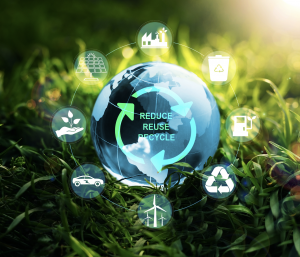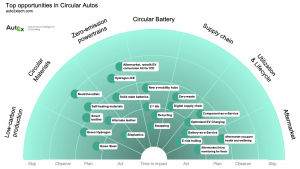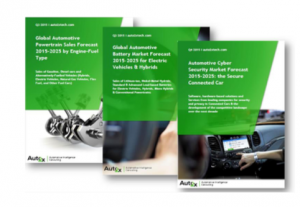
Auto2x’s research identified strategies and innovation clusters for carmakers and auto suppliers, policy for regulators for fully-circular automotive industry
— Auto2x
LONDON, UNITED KINGDOM, March 3, 2023 /EINPresswire.com/ — Circular Autos are vehicles that combine sustainable manufacturing, transparent supply chain, optimized usage throughout their lifecycle and end-of-life. They can contribute to the Automotive industry’s goal of zero-emissions waste and transport decarbonization.
Auto2x identified key opportunities to accelerate the shift to Circular Mobility across manufacturing, vehicle lifecycle and end-of-life. These opportunities cover innovation clusters, strategies, business models and policies, based on their market potential and technological maturity.
The findings form part of Auto2x’s latest study in “Gearing up to Circular Autos: Opportunities from the shift to Sustainable Mobility”. This report unveils the top opportunities in the transition to sustainable mobility and provides an outlook for the technological building blocks and the impact of regulation.
Here are Auto2x’s Top-10 recommendations to accelerate the shift to Circular Mobility.
1. Regulators and policy-makers should evaluate mandatory “Green Automobile Manufacturing”, e.g., with green steel;
2. Automotive players must embrace innovations in exponential technologies, such as AI, Big Data, etc. to achieve quantum leaps in their transition to Circularity, instead of incremental steps;
3. Vehicle manufacturers and shared mobility network operators should collaborate for the development of “Purpose-built” vehicles to electrify ride-hailing and Mobility-on-Demand;
4. Pursue strategies for the decarbonization of the ICE car parc with e-mobility aftermarket kits;
5. Accelerate the shift to SDV-Software defined vehicles, which includes advanced electric architectures and connectivity to optimize zero-emission powertrains;
6. Investigate the optimization of EV Charging infrastructure to close the loop, e.g. charging while driving with electrified roads, while queuing in traffic lights, parked, etc.
7. Explore new CaaS (Circularity-as-a-Service) business models, such as Energy-as-a-Service (EaaS) with integration of Evs in the smart grid, Component-as-a-Service, such as Battery leasing and swapping and more.
8. Increase transparency of supply chain activities and resources using blockchain and digital identities, such as BMW’s digital passport for EV charging with renewable resources;
9. Recyclability for second-life of battery and other components, e.g. Li-Cycle’s lithium-ion recovery with high efficiency to close the loop in battery value chain;
10. Cross-industry collaborations to build secure supply chain for sustainability
SUSTAINABLE MANUFACTURING
1. REGULATORS AND POLICY-MAKERS SHOULD EVALUATE THE MANDATORY TRANSITION TO AUTOMOBILE PRODUCTION USING RENEWABLE AND CARBON-NEUTRAL RESOURCES, SUCH AS GREEN STEEL AND GREEN ALUMINIUM.
Today, more and more governments are accelerating their strategy for zero emissions with battery recycling and second-life mandates. But there is a lack of regulatory harmonization, absence of global cooperation to develop common standards, and consumer awareness are roadblocks to overcome for wider adoption of fully circular mobility.
Green Steel, or non-fossil fuel steel using electricity from renewable resources in automotive manufacturing, can lead to lower emissions. The automotive sector accounts for 12% of overall steel consumption worldwide, second only to the construction sector (Worldsteel, 2018). Green steel can play an important role to the reduction of the carbon footprint of global carmakers. When steel-maker Salzgitter plans to start producing low-carbon steel on a new Volkswagen production route from the end of 2025, they expect it will result in almost 95% fewer CO2 emissions than at present.
A paper by the Oxford Institute for Energy Studies published in March 2022, indicated that “there is a new automotive sector-wide shift towards achieving greener upstream operations and material sourcing in the automotive sector, however this is yet to be mandated through regulation”.
2. VEHICLE MANUFACTURERS AND SHARED MOBILITY NETWORK OPERATORS SHOULD COLLABORATE FOR THE DEVELOPMENT OF “PURPOSE-BUILT” VEHICLES TO ELECTRIFY RIDE-HAILING AND MOBILITY-ON-DEMAND
Optimized vehicle design, tailored to the mobility application, especially for ride-hailing and other forms of shared mobility, or Mobility on-Demand could accelerate the road to zero-emissions. With the demand for Mobility services expected to rise dramatically by 2030, governments are setting mandates for the electrification of shared mobility.
Goldman Sachs estimates that ride-hailing miles will grow four-fold between 2020 and 2030. However, ride-hailing fleets use mostly vehicles designed for private ownership, which are designed differently, compared to ride-hailing needs, especially in highly congested cities. A report by to the ICCT, estimated that Uber’s fleets, who controlled around 60% of the ride vehicles in Europe and the US, emitted 335,000 tons of CO2 in London in 2017, which contributed to a 23% increase in emissions from the taxi and PHV sectors in the UK from 2012 to 2017, even as the number of taxis has declined.
In 2021, California’s Clean Miles Standard mandated that nearly all rideshare vehicles go electric by 2030 to help achieve its climate goals.
There is an opportunity to lower emissions, better user experience and integration with robotaxis.
Purpose-made electric fleets for ride-hailing could reduce emissions in cities. According to a report by the Union of Concerned Scientists in 2020, an electric, non-pooled ride-hailing trip can cut emissions by about 53 per cent. What’s more, the design of vehicles with shared mobility in mind, could offer better user experience by maximizing the space for passengers, incorporate anti-microbial surfaces and materials for better hygiene and more. Finally, another opportunity is the emergence of robotaxis Autonomous, electric and shared robotaxis hold the potential to maximize their utilization and contribute to the financial viability of shared mobility network operators. Robotaxis will be custom-designed to maximize mobility-on-demand.
3. AUTOMOTIVE PLAYERS MUST EMBRACE INNOVATIONS IN EXPONENTIAL TECHNOLOGIES, SUCH AS AI, BIG DATA, ETC. TO ACHIEVE QUANTUM LEAPS IN THEIR TRANSITION TO CIRCULARITY, INSTEAD OF INCREMENTAL STEPS;
Auto2x unveils 3 companies using AI, Data, Computing, IoT, WEB3 are other exponential technologies to accelerate sustainability and Circular Mobility. These solutions have the potential to revolutionize the automotive industry by solving challenges in decarbonization and digitalization of the supply chain.
Posh Robotics who is utilizing computer vision and robotics, to automate EV battery recycling. Posh provides robots that disassemble EV batteries automatically for recycling and qualify battery packs for reuse, refurbish or recycle. The company’s vision is to automate EV battery recycling to accelerate sustainability and scale energy storage.
Everledger created “EV battery digital passports” with Ford to track batteries across their lifecycle. This battery digital passport will allow Ford to gain visibility on out-of-warranty batteries and validate responsible end-of-life recycling, according to their press release. The company is working on projects that digitalize the supply chain for sustainability and better transparency.
IonQ has announced a project with Hyundai to optimize battery chemistry for electric cars through simulation with quantum computing algorithms. IonQ claims it can address many of these issues with quantum technology in areas such as battery efficiency and boosting the capacity of energy grids, according to sources.
OPTIMIZED VEHICLE LIFECYCLE FOR FULL CIRCULARITY
4. OPTIMIZATION OF ZERO-EMISSION POWERTRAINS, NOT ONLY FOR BEVS OR HYDROGEN FUEL CELLS, BUT DECARBONIZATION OF THE ICE CAR PARC WITH E-MOBILITY AFTERMARKET KITS
In terms of new EV sales, Tesla dominates the electric powertrain market with 1.31 million deliveries in 2022, up 40% from 2021. Many passenger car brands are already fully-electric, such as Tesla, but their shift to climate neutrality is underway, with Tesla not making a commitment yet while Polestar has set 2040 at the goal. The Tesla Model 3 and BMW i4 BEVs top the electric efficiency ratings according to reports. The Electrifying.com Efficiency Rating, known as the E-Rating™ with the highest rating of A++.
The share of sales of new electric vehicles in the powertrain mix increases but powertrain decarbonization needs to extend to all legacy vehicles, not just new car sales. In this direction, Toyota’s CEO recently announced a proposal to replace the engine of older cars with EV powertrains.
5. SHIFT TO SDV-SOFTWARE DEFINED VEHICLES, WHICH INCLUDES ADVANCED ELECTRIC ARCHITECTURES AND CONNECTIVITY TO KEEP VEHICLES ALWAYS UP TO DATE
The role of EE architecture is crucial to realize the benefits of high-voltage electrification. Such as APTIV’s Smart Vehicle Architecture, VW’s software platform and Hyundai’s E-GMP which combines a multi-charging system, large-capacity battery system, and flexible use of space.
BEV dedicated architecture and platform, such as the ones developed by Tesla and BMW (i3), offer advantages being designed from the ground up to take advantage of electrification, such as flat underfloor batteries, lower cowl, more cab forward, more cabin space, and optimised safety measures.
On the other hand, BEV dedicated top-hats based on highly-modified ICE architectures, such as Audi’s first-generation e-tron, and Jaguar I-Pace, are quicker to introduce but highly compromised since it is difficult to optimise architecture for ICE and BEV. However, they offer a pragmatic step, which together with the shift towards petrol/diesel mild hybrids, is an interim electrification strategy. Therefore, Premium carmakers Audi and Mercedes-Benz are following Tesla and BMW in the design of a dedicated architecture, such the upcoming Mercedes-EQ line-up.
6. OPTIMIZATION EV CHARGING, WHILE DRIVING WITH ELECTRIFIED ROADS, WHILE QUEUING, E.G. IN TRAFFIC LIGHTS.
Electreon, an Israeli start-up founded in 2013, wants to build electrified roads to charge EVs. The company has announced projects to install its Smart Road Technology in Sweden, Germany & the US.
7. USING EVS FOR ENERGY-AS-A-SERVICE (EAAS) BUSINESS MODEL IN SMART CITIES
A study by a researcher from the Norwegian University of Science and Technology explored how EVs can achieve sustainable energy in smart cities. The findings discuss how EV batteries “offer an untapped opportunity to store electricity from renewable energy sources”.
8. TRANSPARENT RESOURCES USING BLOCKCHAIN AND DIGITAL IDENTITIES, SUCH AS BMW’S DIGITAL PASSPORT FOR EV CHARGING WITH RENEWABLE RESOURCES;
END OF LIFE MANAGEMENT
9. RECYCLABILITY FOR SECOND-LIFE OF BATTERY AND OTHER COMPONENTS, E.G. LI-CYCLE’S LITHIUM-ION RECOVERY WITH HIGH EFFICIENCY TO CLOSE THE LOOP IN BATTERY VALUE CHAIN
10. CROSS-INDUSTRY COLLABORATIONS TO BUILD SECURE SUPPLY CHAIN FOR SUSTAINABILITY
E.g. Catena-X, development of a supply chain between the automotive industry and fashion or beverage industries for sustainable materials or sourcing recycled PET for alternate leather in car interiors.
To learn more about the pace of technology, regulation and player activities in automotive sustainability read Auto2x’s report : Gearing up to Circular Autos: Opportunities from the shift to Sustainable Mobility.
Read our report to learn:
How can Circular Mobility lead the automotive transformation to sustainability;
What is the impact of emission regulations and policies for Sustainable Vehicles;
Key technological enablers and the pace of innovation for Circular Autos;
Trends in consumer sentiment;
Strategies to accelerate the transition to Sustainable Mobility
The evolving player Ecosystem: Leaders vs. Followers
Emerging Circularity Hubs
For more details contact: info@auto2xtech.com
Auto2x, Automotive Intelligence & Consulting
Auto2x Ltd
+44 7825 686532
email us here
Visit us on social media:
LinkedIn
The content is by EIN Presswire. Headlines of Today Media is not responsible for the content provided or any links related to this content. Headlines of Today Media is not responsible for the correctness, topicality or the quality of the content.





